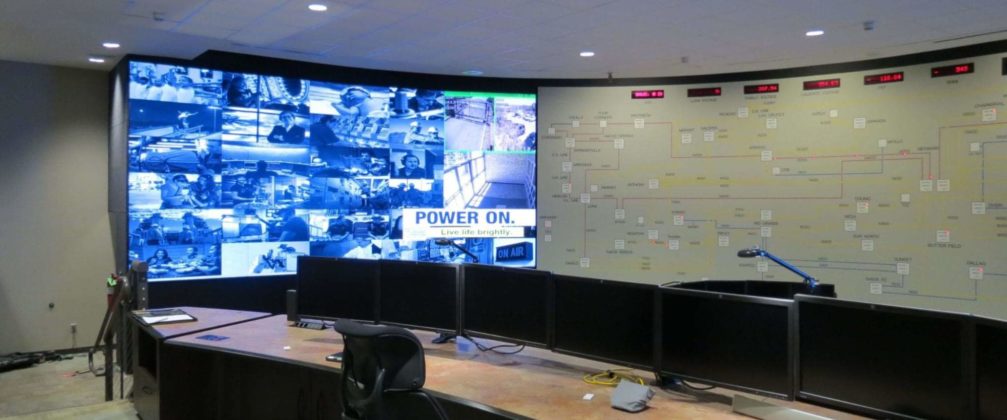While utilities have relied on traditional, cable-dependent AV for decades, newer AV over IP options are moving in to solve bigger, more complex control room display challenges. To help utilities better understand AV over IP and its potential benefits, we’ve assembled answers to some of our clients’ most commonly asked questions about design, cost, and security to explain how it compares to traditional AV.
What are the limitations of traditional AV?
Traditional AV strategies require physical cable such as HDMI to connect an AV source to a transceiver, matrix switch, receiver, and an AV display, and the cable connection that is required has become a major hurdle for utilities who now need to expand their systems to meet modern demands.
Where traditional AV systems once performed well when control room operators all worked in one central location, today’s control rooms often need to share data across multiple locations. Add to this the increasing size and complexity of control rooms and their corresponding AV systems, and you can quickly begin to see a number of shortcomings in the old designs.
For instance, because of the physical cable, traditional designs are limited in the distance they can cover. This can make adding control rooms and training areas and sharing AV information within larger utility complexes logistically challenging and costly.
Also, the number of inputs and outputs on the matrix switch in a traditional AV system is fixed, and adding I/O to expand the system means investing in a larger, and more costly, matrix switch.
What are some AV over IP solutions for these limitations?
AV over IP uses cable or fiber to connect an AV source to an encoder, an IP switch, a decoder, and an AV display, and AV information is transmitted and shared over Ethernet, LAN, WAN, or WiFi. This configuration offers utilities several advantages over traditional designs.
First, distance is no longer limited, which provides a greater level of flexibility in where control rooms and AV equipment can be located and how they are connected. It also offers the option of accessing, configuring, and updating AV devices remotely, which has become increasingly important for multi-site utilities and for responding to emergency situations and natural disaster events.
A second AV over IP solution is the ability to scale the system. Ports on the IP switch can be used to connect additional IP switches to support a virtually limitless number of AV interfaces, and the IP switches typically cost less than their HDMI and matrix switch counterparts.
What do utilities need to know about the security of AV over IP?
Utilities are responsible for the generation, transmission, and distribution of energy and other resources, and as such, security is always a top priority when designing any system involved in safe and reliable delivery.
Naturally, questions about the security of an AV over IP system are warranted, but they are often driven by the misconception that IP technology compromises security and opens the system up to hacking in a way that traditional AV strategies do not.
The reality is that neither traditional AV nor AV over IP is impervious to outside intrusion or hacking, and there are many common-sense ways to prevent such intrusion. Just like any other secure network in an operation, AV over IP can employ encryption technologies and access can be protected by passwords and permissions. Thus, the security of an AV over IP system is much more dependent on the expertise of your IT personnel than it is on the system itself.
Additionally, while traditional AV does not alter the information from the AV source, AV over IP encodes the information and converts it into data packets, and some IT professionals feel this adds a higher level of security.

Should a utility invest in proprietary AV over IP or opt for standardization?
Utilities that have outgrown traditional AV strategies and want to expand using AV over IP solutions often need to choose between a single-source supplier with a proprietary solution or piecing together their own standardized solution.
A single-source supplier offers the reassurance that their products will match specifications and performance claims and can often provide an easier implementation experience. Comparatively, a standardized solution, while requiring more time and effort for your IT team to assemble, will allow you to pick and choose from a variety of manufacturers and completely customize your solution.
Ultimately, you should go with the solution that best serves your utility’s specific AV needs, and that includes meeting your budget and scalability requirements.
Advice for getting started
Moving from traditional AV to AV over IP is a decision that impacts personnel at multiple levels of an organization, which is why it is important to involve as many stakeholders as possible when exploring whether or not to shift your AV strategy.
Key considerations should include
- the size and complexity of your operation
- the potential need for future expansion
- the need for remote accessibility
- the age of your current control room AV equipment
- your available budget
The more people you involve in the planning process, the more likely you will be to choose a solution that best meets all of your utility’s needs now, and in the future.


